Many thanks to SWLing Post contributor, Dan Robinson, for the following guest post and review:
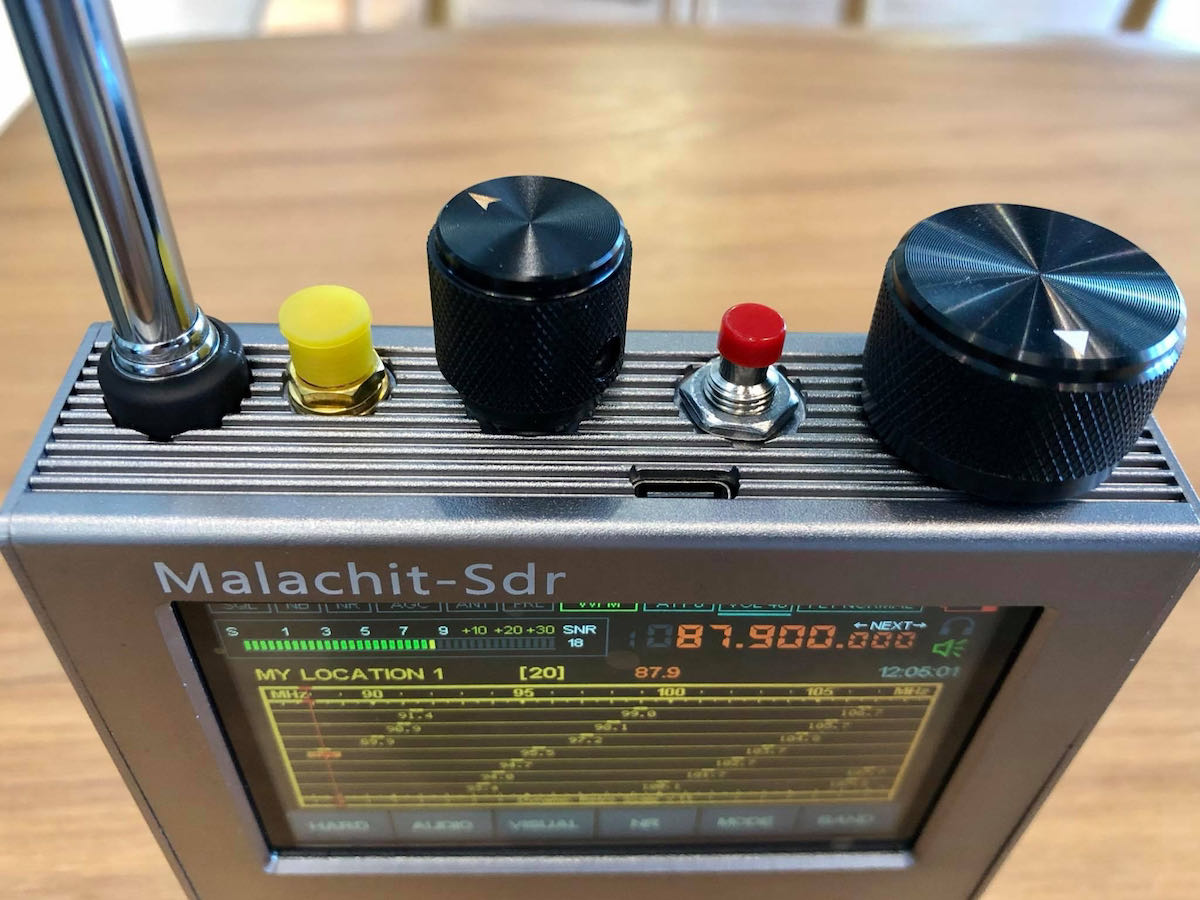 Two Chinese Clones: A Look at Noise Levels
Two Chinese Clones: A Look at Noise Levels
Arriving recently here in the radio shack, were a Chinese clone under the name of “Fire Brothers” and another under the name HFDY. I thought it would be constructive to note the key differences between these two clones, both of which are running Malahit 1.10c firmware, and post some video of a brief comparison.
A note in advance of any comments – I am primarily a HF listener so these comparisons do not cover frequencies above 30 MHz. For those whose focus is on higher frequencies I recommend looking through the many comments on the Malahit Facebook group and Telegram by those who use these receivers in those ranges.
HFDY
- Constructed of metal-like material (a correction from my previous articles that this is fiberglass of the kind used in printed circuit boards – thanks to Georgiy of Malahiteam for pointing this out)
- Front speaker grille is gold color and appears to be metal but may be fiberglass as well – audio is quite good
- Two top-mounted antenna jacks, one 50 ohm, the other Hi-Z (makes switching between HF and FM/VHF reception easier) with in-use LED indicators
- Two high quality right side mounted black metal encoder knobs with large power button (clear printed Frequency/STDBY/Volume printed on panel)
- Cabinet held together with TORX screws
- 1.10c firmware
- Receiver is elongated left to right to accommodate left side front-firing speaker, but is thinner overall and could be easily placed in a pocket though not recommended to prevent damage
- Like every one of these SDRs, suffers from body sensitivity to touch which reduces signal levels unless some sort of additional ground is attached to cabinet
- Internal flat-type Lithium battery of 3300 mAh though apparently capable of fitting up to 8000 mAh
“FIRE BROTHERS”
- Vertical format with encoder/volume knobs on top makes for surprisingly easy tuning, in some respects superior to side or front mount controls. Power and USB-C also top-mounted
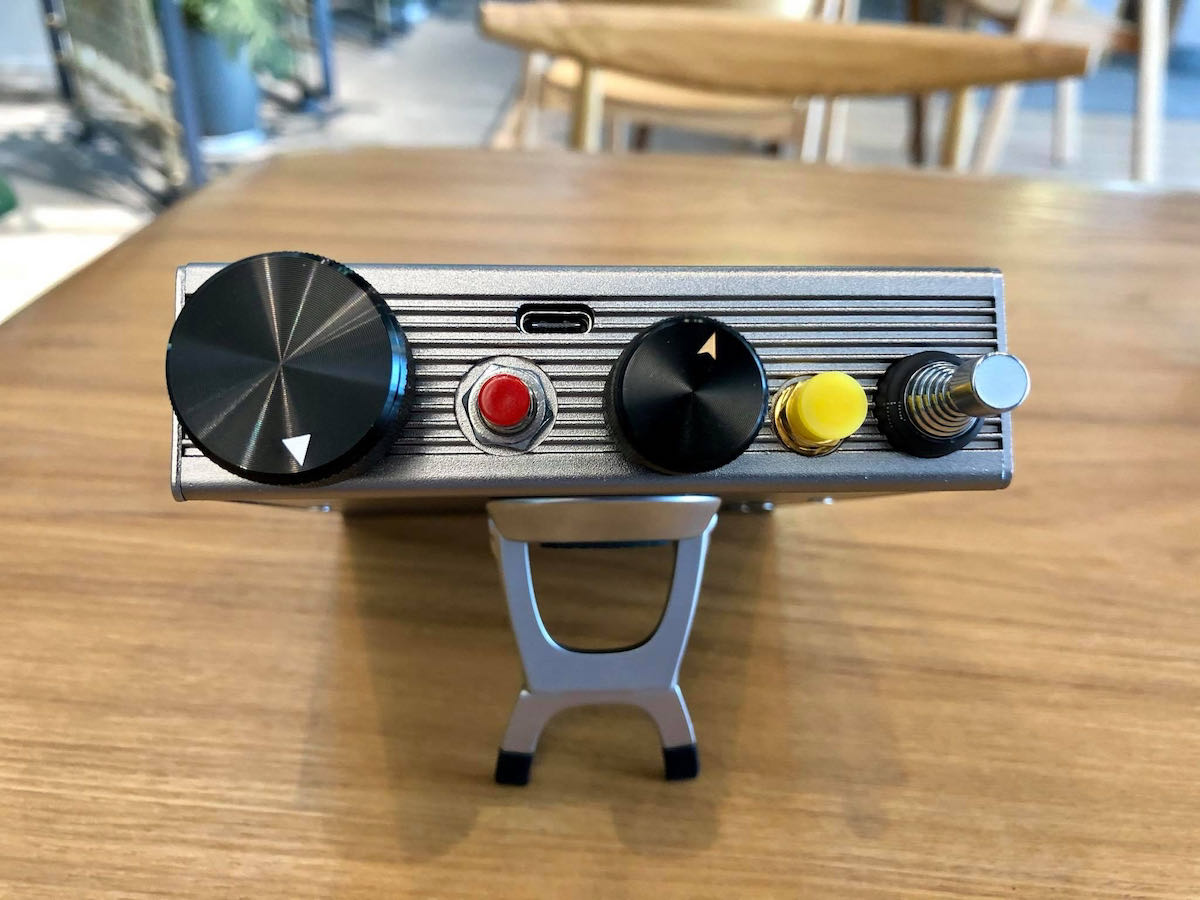
- Top-mounted antenna jacks, including one very robust built-in whip (with rubber grommet at base) telescopes into receiver body
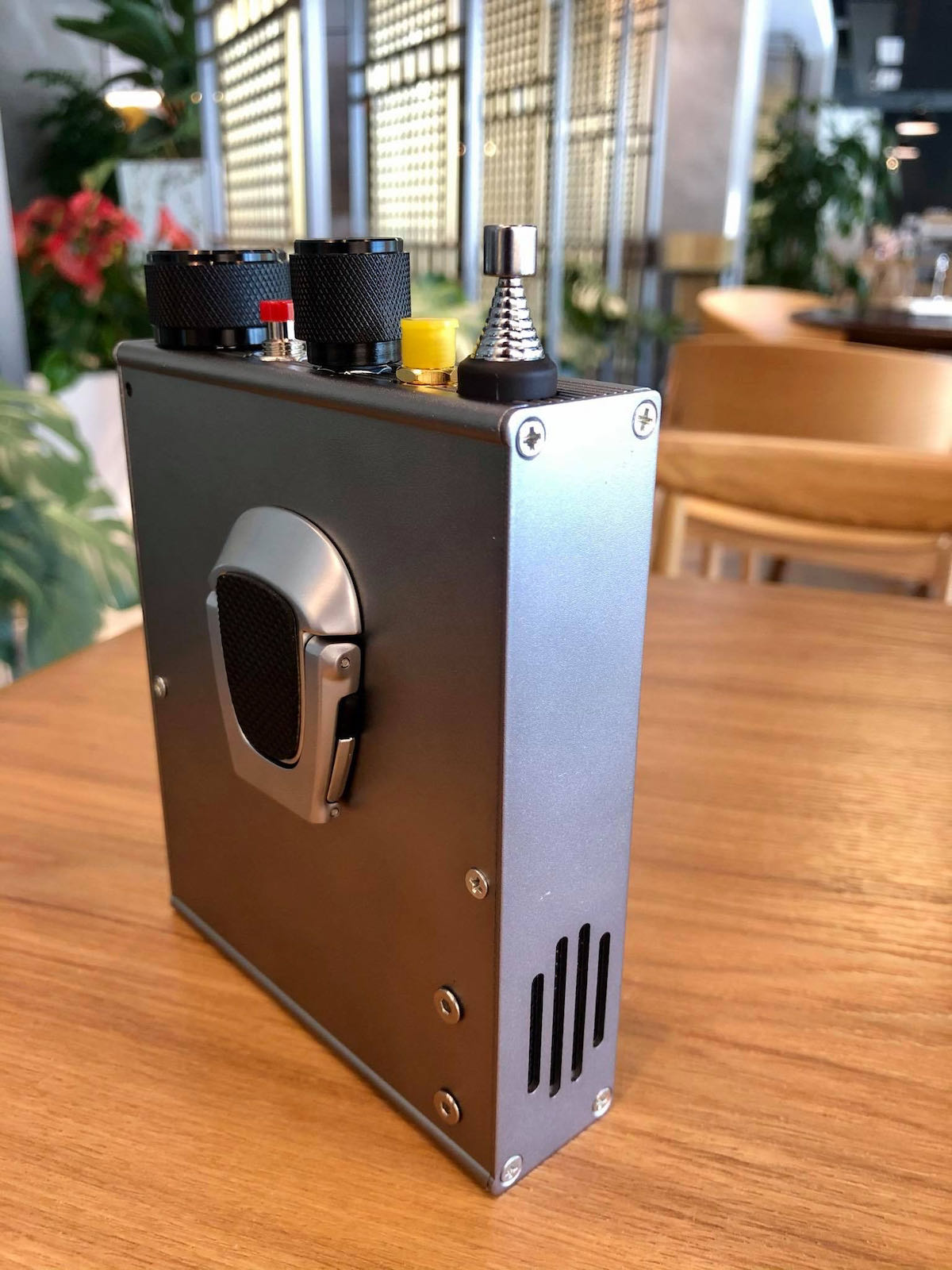
- Actual metal cabinet, TORX type screws
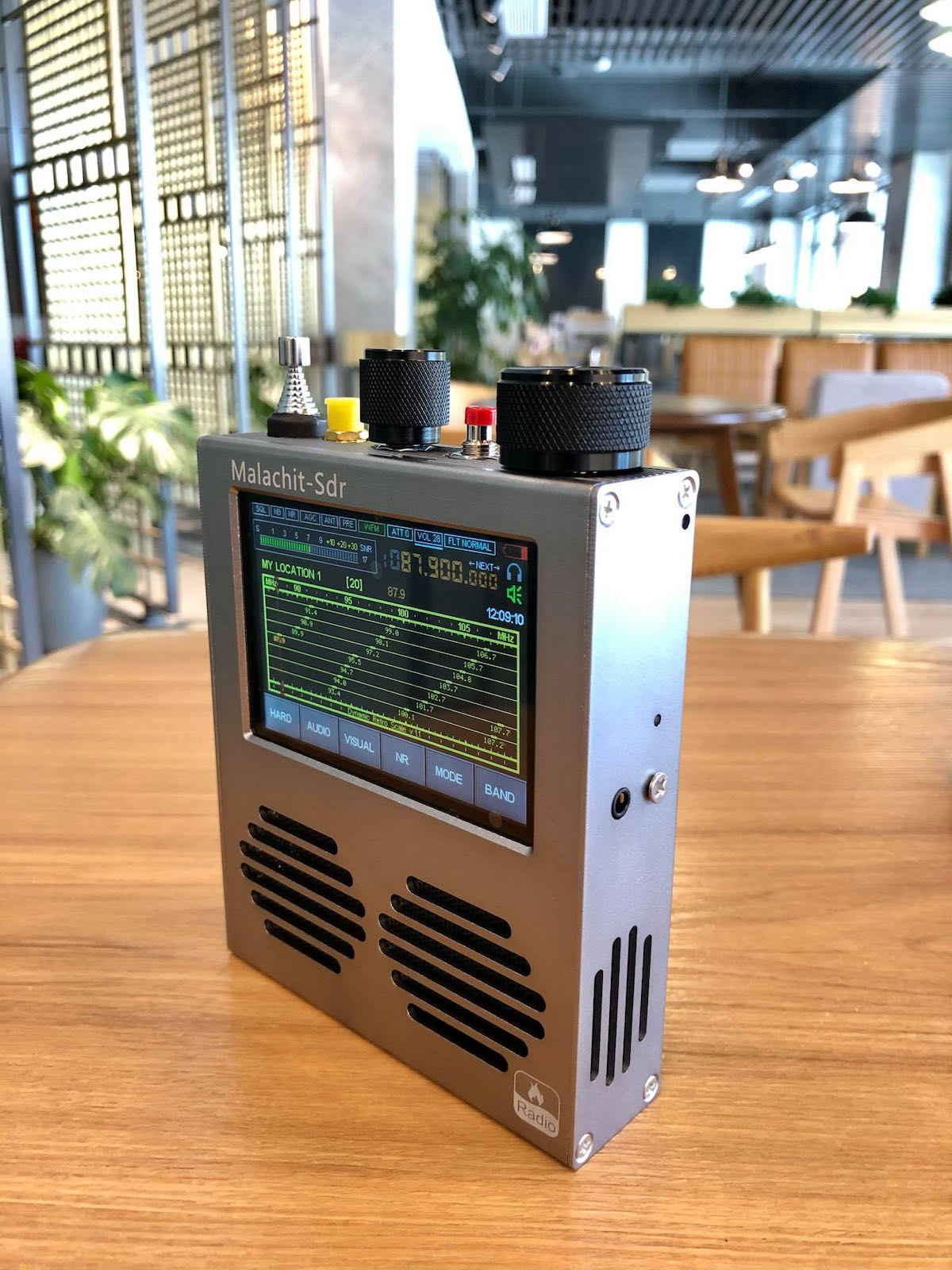
- Large front-firing speaker grille with wrap-around side outlets significantly improves sound with listenable audio possible at much lower volume settings than HFDY and DSP-2
- Despite robust metal cabinet, much more internally-generated noise than HFDY and DSP-2 and more vulnerable to environmental noise – in some cases stations only audible with PRE-AM and NR engaged
COMMENTS ON “FIRE BROTHERS”
 Before it arrived, I had high hopes for this vertical format clone, which is labeled as Fire Brothers. These clones have been seen on eBay for some time – as of this writing one other appears but with only a single top-mounted antenna jack, and encoder knobs on the right side. Interestingly, this appears also under HFDY and other seller names.
Before it arrived, I had high hopes for this vertical format clone, which is labeled as Fire Brothers. These clones have been seen on eBay for some time – as of this writing one other appears but with only a single top-mounted antenna jack, and encoder knobs on the right side. Interestingly, this appears also under HFDY and other seller names.
In some respects, particularly when switching frequency STEP and rapid tuning, this top-mounted encoder knob solution is actually more comfortable than side or front mounted. But as I observed, currently the “Fire Brothers” version of the receiver appears to be the only one that places all five main controls on top.
Where performance is concerned, again I had hopes that the all-metal body of the receiver would help with touch-sensitivity. Unfortunately, that does not appear to be the case. There is some substantial signal drop off when leaving the receiver standing on its own as opposed to hand holding.
Most disappointing, after using the Russian Malahit DSP-2 and then the HFDY receivers, was obvious high noise levels on the Fire Brothers unit – internally-generated and apparent leakage into the circuit, of environmental house noise. At times, this was so bad as to render the Fire Brothers SDR unusable in my view.
Another point – the Fire Brothers SDR appears to require almost constant use of the PRE-AMP setting. Tuning 15,770 kHz or 9,330 kHz without it yielded a barely audible signal. Engaging the amplifier brought signals back to at least normal level. This was noticeable also on the stronger 9,980 kHz frequency of a U.S. religious broadcaster – with PRE-AMP activated, it was easy listening, but the signal dropped right off the cliff without it.
Samples were taken mostly indoors on whip antennas and an indoor You Loop – HF conditions were not great, but sufficient to provide a comparison between the clones.
COMMENTS ON HFDY
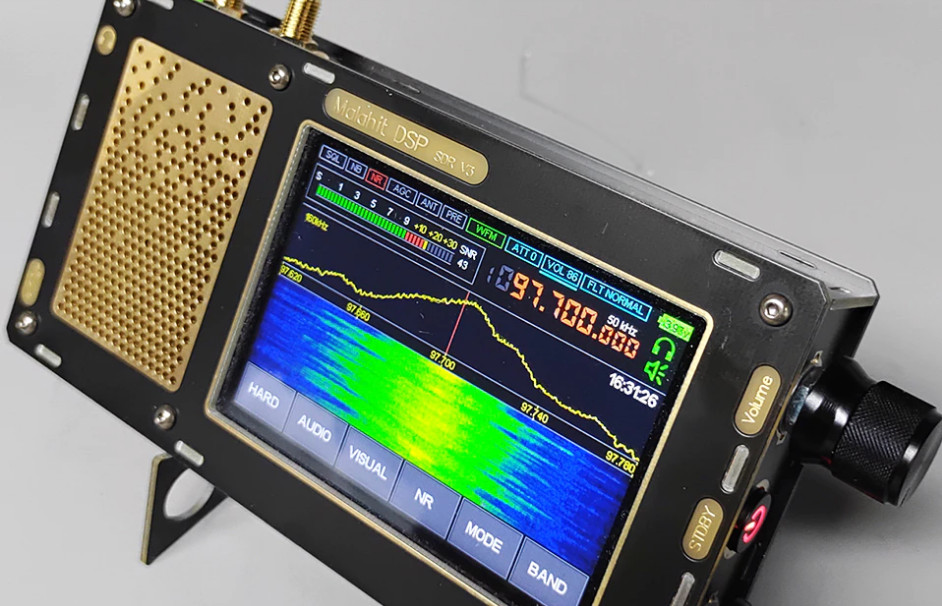 In comparison, the HFDY clone did quite a bit better. internally-generated noise was lower, as was the impact of environmental noise at various locations inside my house. In one particular location farthest from incoming broadband and other connections, the HFDY was able to hear stations whereas the Fire Brothers was not.
In comparison, the HFDY clone did quite a bit better. internally-generated noise was lower, as was the impact of environmental noise at various locations inside my house. In one particular location farthest from incoming broadband and other connections, the HFDY was able to hear stations whereas the Fire Brothers was not.
Use of the PRE-AMP, while almost always improving reception on shortwave frequencies, was not as critical as it was on the Fire Brothers receiver. Noise levels as observed on the HFDY display were noticeably lower.
Tests of the HFDY on mediumwave, and in comparison to the Fire Brothers SDR, showed interesting results as well. HFDY was clearer, with less noise, than the Fire Brothers. I show this in the video, on 630 kHz WMAL and 1090 kHz WBAL. Those stations could be heard more clearly using HFDY than on the Fire Brothers receiver.
Video Comparison
OVERVIEW
For whatever reason, and despite seemingly more robust metal cabinet of the Fire Brothers brand, the HFDY receiver almost routinely cleaned the clock of the other clone. As you can see in the video, noise level differences were striking.
Both the HFDY and Fire Brothers SDRs use 1.10c firmware whereas the Russian-made DSP-2 uses the latest official 2.10D firmware. Both of the clones were sold as the “advanced” version with official firmware, and both have CPU identifications.
Meanwhile, one user on the Malahiteam Telegram group provided the following summary of his experiences using the Russian DSP-1 and DSP-2 receivers (note that this user had removed the L7 inductor):
“DSP1 and DSP2 Users: I did [a] comparison of sensitivity between my DSP1 (with optional board) and DSP2 (with Inductor L7 removed) yesterday comparing Longwave and MW to 1700kHz . Testing was done using a Comet SMA-W100RX 1m long telescopic whip (outdoors and indoors) and on a G5RV 34 meter long wire antenna.
HiZ and 50ohm settings as well as PREAMP, RF Gain and Attenuator settings were used for optimal reception and both ran on full charged batteries. Here are my observations:
[On] Longwave 60kHz to 450kHz [the] DSP2 heard weak airport navigation beacons far better than [the] DSP1. MW performance [was] about the same between 530kHz and 1000kHz. [The] DSP1 worked much better with weak AM broadcasters between 1000kHz and 1700kHz where [the] DSP2 had no reception at all on certain weak stations while [the] DSP1 heard the weak station and [could] identify the song played and radio station identification.
[On] SW and up – seems like they are equal in performance. I will work on a detailed plot to characterize both radios using a calibrated signal source that modulates in AM/FM and SSB when I get a chance. I have a technician friend who will help.
. . .I suspect that DSP Malihit receivers reception performance would vary very slightly between each other (I am referring to comparing one DSP-1 to another DSP-1 and DSP-2 compared to another DSP-2). I like the DSP-2 more as noise on VHF is virtually non-existent and LW performance [is] outstanding.”
Another user on the Telegram group stated that “MW performance [was] about the same between 530kHz and 1000kHz” suggesting that [the] DSP-1 is the same as the DSP-2 or the same on LW [and] better [than the] DSP-2.”.
In a comment on my previous article, Georgiy of Malahiteam responded with some observations covering a number of points and I thank him for this quick response.
He acknowledges that a front-facing speaker will produce better audio and says shielding in the HFDY clone appears to have been done well, as shown in a photo, but reiterates that the most critical path of interference is “direct airborne….from the display to the antenna” thus shielding is “absolutely without impact.”
As for antennas, Georgiy also reiterates that for HF/Shortwave reception, it is always better to use longer antennas over whips. And he questions the advisability of leaving two antennas simultaneously saying that this “worsens the reception due to the fact that the resistance of the receiver will no longer be 50 ohms….and alignment will be broken.”
Finally, Georgiy also states that Malahiteam is not connected with Chinese manufacturers in any way, with copyright belonging only to the Russian team.
“Some clone manufacturers buy keys from us,” he says, but “this number is disproportionately less than the total number of clones sold.”
There continues to be one major ongoing reality for current and prospective users of Malahit/Malachite receivers, whether original Russian versions or Chinese clones: these really are not good performers on a whip antenna.
As one user noted: “When using the whip antenna the interference from the touch screen is not acceptable” – which pretty much sums the continuing challenge for developers and clone makers.
Some people, of course, have been trying MLA-30 and amplified antennas from Greece with the Malahit receivers with varying results. I have never found the Greek antennas to do much to improve things.
When testing both of these particular clones, as with the Russian-made DSP-2, on an un-amplified You Loop located indoors, things improved over using just a telescopic whip. But as noted above, the “Fire Brothers” SDR was all but useless due to internally-generated and environmental noise at several indoor locations.
CONCLUSIONS
Would I recommend acquiring either of these China-made clones? The answer is, as with many things, yes and no.
The cost of acquiring one of these Chinese clones is in the $150 to $180 range. The HFDY has certain qualities that push it above the crowd – with considerable curb appeal with its front gold speaker producing excellent audio.
It comes with an attractive package with carrying case, USB-C, small metal stand, and a rubber whip antenna.
The other clone under the “Fire Brothers” label is the only one of its kind seen with all controls and jacks at the top of the cabinet. It’s an interesting arrangement (reminds one of some of the old Rhode & Schwarz frequency measurement devices).
Placement of encoders at the top does not, in my view, significantly reduce the tuning experience.
Add to this what appears to be a double speaker with wrap-around side grilles (this could be a single larger speaker with just additional radiating outlets) producing superior sound and you have another interesting feature which enhances listening.
As for battery power, reports from users indicate that the HFDY can accept up to an 8,000 mAh flat lithium battery, though I have not opened the cabinet on mine to check on how easy it would be to replace. The thickness of the “Fire Brothers” SDR seems to indicate that user replacement would also be possible on that clone.
Meanwhile, it remains to be seen how quickly the Russia Malahiteam can bring to market their DDC version of the Malahit, which we can hope has less noise than the original DSP-1 and DSP-2 versions of the receiver, and what cost to the consumer.

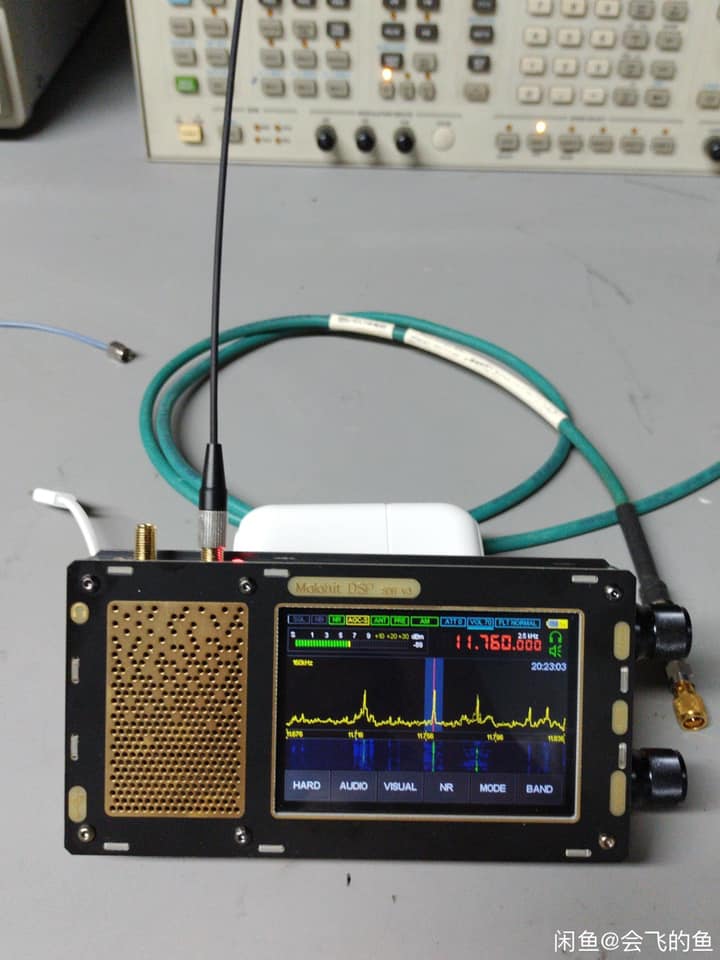
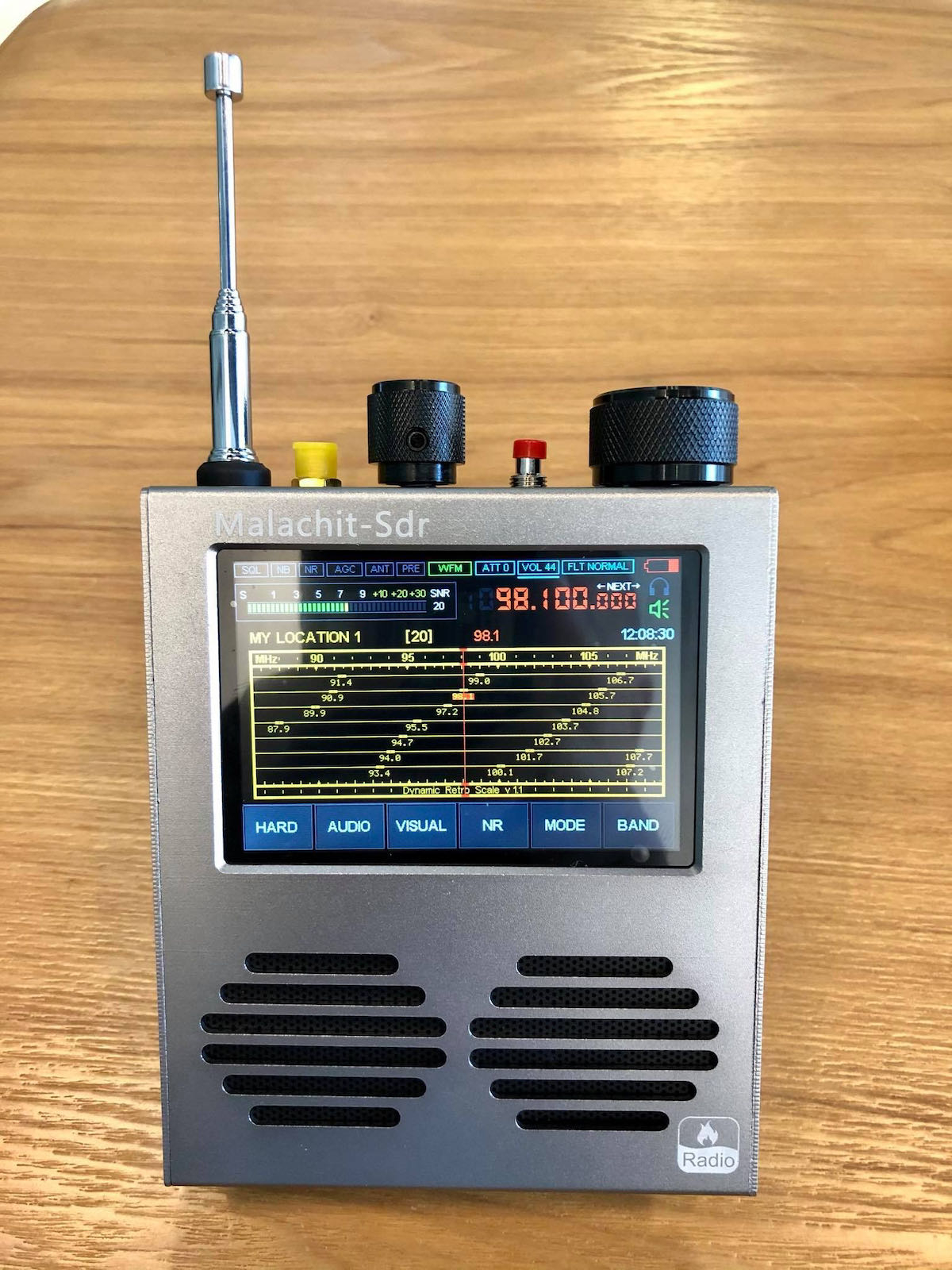
I’m curious to know if anyone has used these radios on the 6 meter band or more preferably the VHF-low band. I would like to use this radio for meteor scatter. I have the cheap rtl-sdr and it works fairly well for this but isn’t really portable since a computer needs to be attached. Does anyone know the best forum for asking this question? Not too many meteor scatter geeks out there… Thanks!
Dan, what are these ‘amplified antennas from Greece’ you mentioned?
Thanks…Mike
https://www.ebay.com/itm/152496203358
Something as like this
The ham code is from Thessaloniki but he lives in Athens
These aren’t amplified, if the ebay description is to be believed. They are passive and tuned, but as there is no power supply in the description, then there’s no amp
Think of the Chameleon line of tuned antennas. It’s a similar principle.
Mike
Personally I doubt that I would be interested in a DDC version of the Malahit.
The current limited coverage mentioned is one point against it, the other one would presumably be cost?
The Afedri LAN which has been on the market for some time now and has a good track record offers 30 kHz to 1700.00MHz continuous frequency range for $339, plus $15 for a mechanical tuning encoder of $25 for an optical one. No internal battery though.
I’m puzzled by your comment regarding the switch to double battery (18650) trays on the Russian-made Malahit being a positive development. I’ll agree that more battery storage is is an advantage, but I can’t recall having seen a single complaint regarding the battery life of the Malahit, did I miss something?
Information for anyone considering these — Alibaba is one source, and total shipping for these
was 3 to 4 weeks. They seem to get held up in New Jersey and even after clearing customs, they
seem to sit for a long time before being given over to a delivery service or to USPS. For those not
familiar with the Russian Malahit, you can pay for Russian Post Express which speeds things up as
far as obtaining a DSP-2. My advice: wait a few months until the picture clarifies — the Malahiteam
in Russia appears to be finalizing a DDC (Direct Digital Conversion) version of the DSP-2, perhaps this
will be available by end of year, perhaps not. For now, I would say that anyone purchasing one of the Chinese clones is taking a bit of a chance with quality control. One positive development is the switch to double battery (18650) trays on the Russian-made Malahit.
Does it always take from one to three months to receive the product once you place your order?
Yes it does, it’s what’s known as “supply and demand”?
From whom can these radios be purchased ?
You need to email Georgiy in Russia.
His email address is [email protected]